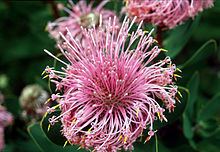Rank Species | ||
 | ||
Similar Isopogon cuneatus, Isopogon anethifolius, Isopogon anemonifolius, Isopogon dawsonii, Isopogon formosus | ||
Isopogon latifolius is a shrub of the family Proteaceae that is endemic to the southwest botanical province of Western Australia.
Contents
Description
Isopogon latifolius grows as a woody shrub with an erect habit to 2.5 m high. The new growth is covered in fine hairs. The thick narrow leaves are 4–10 cm long and obovate in shape. Flowers appear between July and October. The showy pink flower heads are 4 to 5.5 cm in diameter.
Taxonomy
The species was first formally described by botanist Robert Brown in 1830, based on material collected by William Baxter at King George's Sound. The specific epithet is derived from the Latin words latus "wide" and folium "leaf". In 1891, German botanist Otto Kuntze published Revisio generum plantarum, his response to what he perceived as a lack of method in existing nomenclatural practice. Because Isopogon was based on Isopogon anemonifolius, and that species had already been placed by Richard Salisbury in the segregate genus Atylus in 1807, Kuntze revived the latter genus on the grounds of priority, and made the new combination Atylus latifolius for this species. However, Kuntze's revisionary program was not accepted by the majority of botanists. Ultimately, the genus Isopogon was nomenclaturally conserved over Atylus by the International Botanical Congress of 1905.
Distribution and habitat
Isopogon latifolius is found from Albany and the Stirling Range eastwards to the vicinity of Cheyne Bay. It grows on hilltops and stony outcrops and slopes, in association with sandstone, quartzite and schist. It grows in heath, scrub, or low woodland.
Ecology
This plant is extremely sensitive to dieback from Phytophthora cinnamomi and is at risk of extinction from it in the wild.
Cultivation
The showiest of the isopogons, I. latifolius can be grown in regions with low humidity and in positions with good drainage, but will die readily if these conditions cannot be met. It has been grafted successfully onto Isopogon anethifolius. I. latifolius is used in the cut flower industry.
